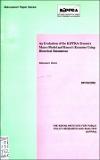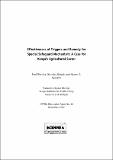Discussion Paper No. 59 of 2006 on an Evaluation of the KIPPRA-Treasury Macro Model and Kenya's Economy Using Historical Simulations
View/
Publication Date
2006Author
Type
KIPPRA Publicationsviews
downloads
Metadata
Show full item recordBy
Were, Maureen
Abstract/
Model simulations are perfonned for different reasons, such as policy evaluation, historical policy analysis and model testing. Ex ante simulations tend to be more popular, particularly for the purposes of evaluating policies before they are implemented. Although there is less experience with ex post modeling, simulations concerning the past are just as interesting as those concerning a future period. The KIPPRA-Treasury Macro Model (KTMM) is a macroeconomic model for the Kenyan economy and a vital tool in planning and policy ·making process. It has been in operation since August 2000. After a period of time, it is generally important to analyse the perfonnance of the model, particularly in predicting specific variables. Using historical simulation analysis, the paper evaluates KTMM in tenns of robustness of its predictive power and, more importantly, provide a better understanding of the past structural economic changes and policy regimes focusing on the period 1973-2003. The analysis shows that most of the variables, such as levels of private investments and private consumption, have been operating below their potential values, based on the simulated trends depicted by the respective equations in the model, particularly in the later years. The exchange rate simulations show a marked appreciation of the Kenya shilling against the US dollar since the early 2000s. This has implications for sectors like the export sector, which is key to spearheading economic growth. The simulation analysis also shows that (total) wages in the formal private sector increased significantly in the most recent period considered (1998-2003). In general, there is potential for the economy to perform better and what is needed are measures aimed at resuscitating the economy.
Publisher
The Kenya Institute for Public Policy Research and AnalysisSeries
DP/59/2006;Collections
- Discussion Papers [309]
Related items
Showing items related by title, author, creator and subject.
-
Discussion Paper No. 75 of 2007 on Free Secondary Education in Kenya: Costs, Financing Sources and Implications
Ngware, Moses; Onsomu, Eldah; Kiriga, Benson & Muthaka, David (The Kenya Institute for Public Policy Research and Analysis, 2007)The study analyses the feasibility of Free Secondary Education (FSE) in Kenya. Its purpose is to present an analysis on whether Kenya can afford FSE and how such a programme can be financed without compromising the gains ... -
Discussion Paper No. 87 of 2008 on Growth and Distribution of Factor Incomes in Kenya: A Social Accounting Matrix Perspective
Mwendwa, Mwende (The Kenya Institute for Public Policy Research and Analysis, 2008)Economic growth and income distribution are two issues that are currently dominating policy decisions of both developed and developing countries. Governments across the globe are struggling to find an economic solution ... -
Discussion Paper No. 69 of 2007 on Effectiveness of Triggers and Remedy for Special Safeguard Mechanism: A Case for Kenya's Agricultural Sector
Miencha, Fred; Waiyaki Nicholas and Nyangito, Hezron O. (The Kenya Institute for Public Policy Research and Analysis (KIPPRA), 2007)This paper provides an analysis of the effectiveness of the proposed reference price and volume triggers in the on going WTO negotiations on “Special Safeguard Mechanism” (SSM). The SSM is to be used by developing countries ...




